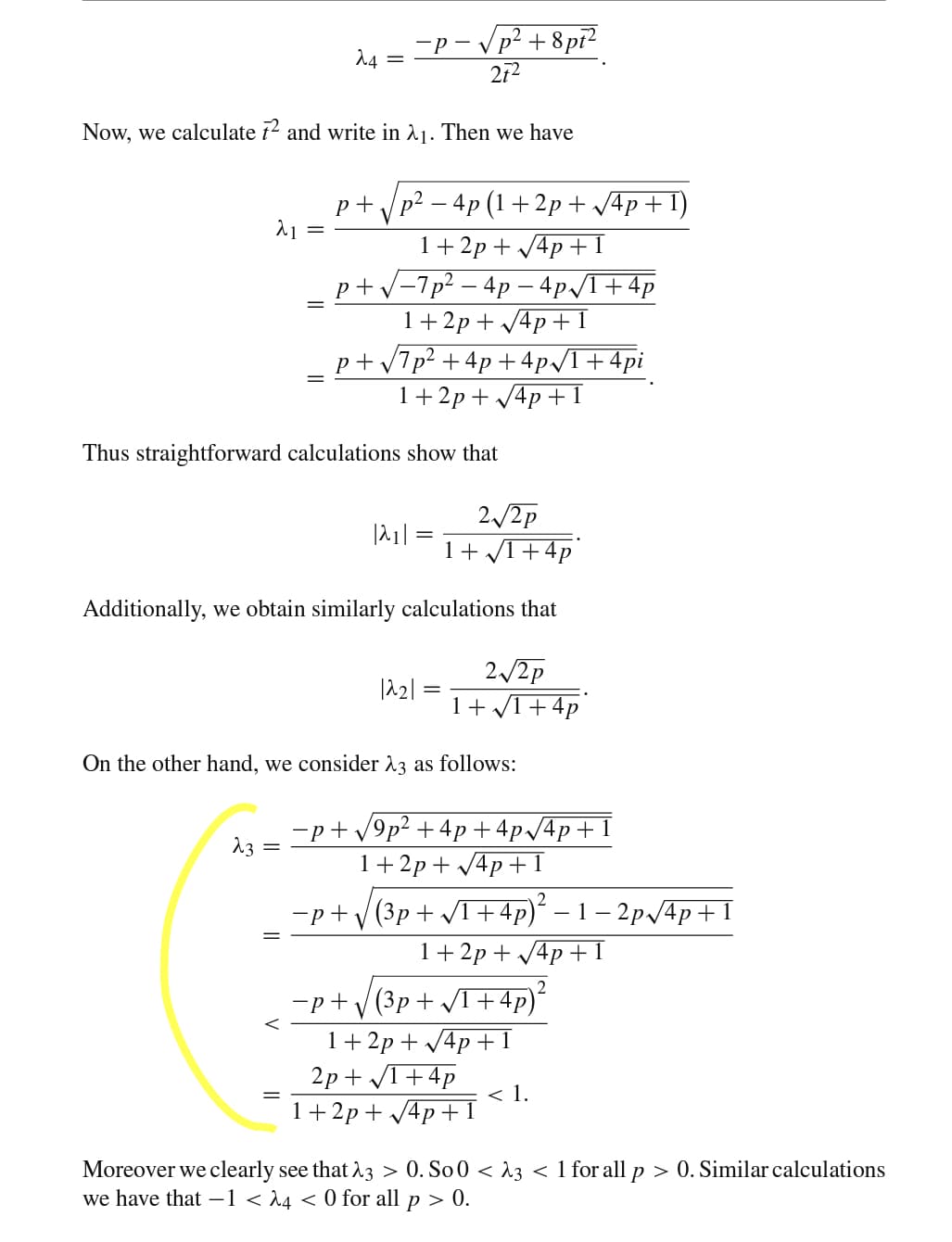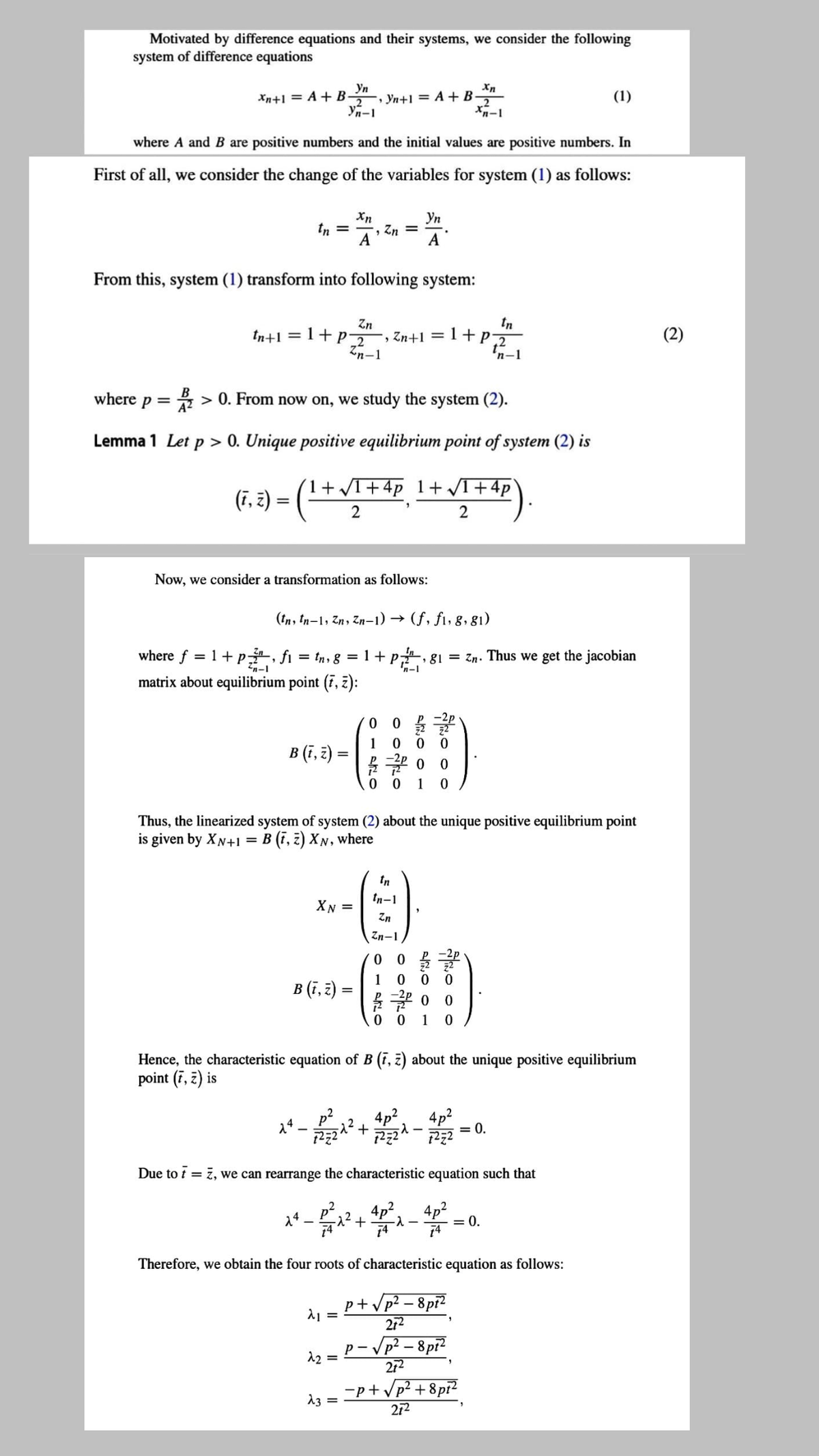On the other hand, we consider 23 as follows: -p+v9p? +4p+4p/4p+1 1+2p+ /4p+I 13 -p+V(3p + /T+4p)ʻ – 1 – 2p/4p+1 1+2p + /4p +1 -p+V(3p+ +4p)* 1+2p+ /4p+1 2p+ I+4p < 1. 1+2p + /4p+1
On the other hand, we consider 23 as follows: -p+v9p? +4p+4p/4p+1 1+2p+ /4p+I 13 -p+V(3p + /T+4p)ʻ – 1 – 2p/4p+1 1+2p + /4p +1 -p+V(3p+ +4p)* 1+2p+ /4p+1 2p+ I+4p < 1. 1+2p + /4p+1
College Algebra (MindTap Course List)
12th Edition
ISBN:9781305652231
Author:R. David Gustafson, Jeff Hughes
Publisher:R. David Gustafson, Jeff Hughes
Chapter8: Sequences, Series, And Probability
Section8.5: Mathematical Induction
Problem 27E
Related questions
Question
Show me the steps of deremine yellow and inf is here i need evey I need all the details step by step and inf is here. It complete

Transcribed Image Text:—р — у
- Vp² + 8pr²
14 =
212
Now, we calculate 72 and write in 11. Then we have
p+ Vp? – 4p (1 + 2p+ /4p+ 1)
1+2p + /4p +1
p + v-7p² – 4p –- 4p/I+4p
1+2p + /4p+ 1
p+ /7p? + 4p + 4p/T+4pi
1+2p+ /4p +1
Thus straightforward calculations show that
2/2p
1+ /I+4p
Additionally, we obtain similarly calculations that
2./2p
|^2| =
1+ /1+4p
On the other hand, we consider 13 as follows:
-p+ v9p2 +4p+4p/4p+1
13
1+2p+ V4p +1
-p+V (3p + T+4p)ʻ – 1 – 2p 4p+I
1+ 2p + 4p +1
2.
-p+V(3p+ /T+4p)²
1+ 2p + V4p +1
2р + +4p
< 1.
1+2p + 4p+1
Moreover we clearly see that 23 > 0. So0 < 13 < 1 for all p > 0. Similar calculations
we have that -1 < 4 < 0 for all p > 0.

Transcribed Image Text:Motivated by difference equations and their systems, we consider the following
system of difference equations
Yn
, Yn+1 = A + B-
Yn-1
Xn+1 = A + B-
2
(1)
where A and B are positive numbers and the initial values are positive numbers. In
First of all, we consider the change of the variables for system (1) as follows:
Xn
, Zn =
A
Уп
tn =
A
From this, system (1) transform into following system:
tn
Zn
, Zn+1 = 1+P2
Zn-1
tn+1 = 1+P2
(2)
%3|
'n-1
where p = > 0. From now on, we study the system (2).
A2
Lemma 1 Let p > 0. Unique positive equilibrium point of system (2) is
(1+ I+4p 1+ VI+4p
(F, 2) = ( -
2
2
Now, we consider a transformation as follows:
(tn, tn-1, Zn, Zn-1) →
(f, fi, 8, 81)
where f = 1+ p, fi = tn, g = 1 + p, 81 = Zn. Thus we get the jacobian
'n-1
2n-1
matrix about equilibrium point (7, z):
1
B (,३) =
12
0 0
1
Thus, the linearized system of system (2) about the unique positive equilibrium point
is given by XN+1
B (i, 2) XN, where
In
tn-1
XN =
Zn
Zn-1
1
B (ī, 2):
0 0
1
Hence, the characteristic equation of B (i, z) about the unique positive equilibrium
point (7, z) is
4p2
+
4p2
= 0.
14
Due to t = 7, we can rearrange the characteristic equation such that
²+ 4p², 4p2
74
14
= 0.
Therefore, we obtain the four roots of characteristic equation as follows:
p+ Vp? – 8pi?
272
– Vp² – 8pi?
212
p- V
12 =
-p+/p? + 8pi?
272
13
%3D
Fo o o
Expert Solution
This question has been solved!
Explore an expertly crafted, step-by-step solution for a thorough understanding of key concepts.
Step by step
Solved in 2 steps with 2 images

Recommended textbooks for you

College Algebra (MindTap Course List)
Algebra
ISBN:
9781305652231
Author:
R. David Gustafson, Jeff Hughes
Publisher:
Cengage Learning

Linear Algebra: A Modern Introduction
Algebra
ISBN:
9781285463247
Author:
David Poole
Publisher:
Cengage Learning

Algebra & Trigonometry with Analytic Geometry
Algebra
ISBN:
9781133382119
Author:
Swokowski
Publisher:
Cengage

College Algebra (MindTap Course List)
Algebra
ISBN:
9781305652231
Author:
R. David Gustafson, Jeff Hughes
Publisher:
Cengage Learning

Linear Algebra: A Modern Introduction
Algebra
ISBN:
9781285463247
Author:
David Poole
Publisher:
Cengage Learning

Algebra & Trigonometry with Analytic Geometry
Algebra
ISBN:
9781133382119
Author:
Swokowski
Publisher:
Cengage

Algebra: Structure And Method, Book 1
Algebra
ISBN:
9780395977224
Author:
Richard G. Brown, Mary P. Dolciani, Robert H. Sorgenfrey, William L. Cole
Publisher:
McDougal Littell